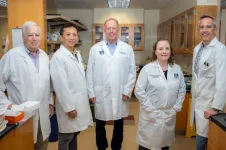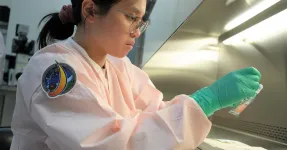(Press-News.org) AUGUSTA, Ga. (May 23, 2023) – Antiretroviral cocktails can make human immunodeficiency virus, or HIV, undetectable and untransmittable, but both the virus and its treatment can also accelerate aging of bone and muscle.
Now Medical College of Georgia scientists are looking at drugs already being studied in clinical trials for cancer to help put the brakes on these classic indicators of aging that can lead to falls, fractures and early frailty.
“These drugs are doing what they are supposed to be doing: They are extending lifespan. Now what we need to do is deal with the side effects so you can extend healthspan as well as lifespan,” says Meghan McGee-Lawrence, PhD, biomedical engineer in MCG Department of Cellular Biology and Anatomy at Augusta University.
“They call it ‘accentuated’ aging,” says Mark Hamrick, PhD, bone and muscle biologist and co-director of the MCG Center for Healthy Aging. “Bone and muscle changes you normally see in a 75-year-old person start to show up in a 65-year old,” he says as he looks at graphs of walking gait and speed and how they decline with age.
Hamrick and McGee-Lawrence are co-principal investigators on a new $3.2 million grant (1RO1AR082307-01A1) from the National Institute of Arthritis and Musculoskeletal and Skin Diseases to identify logical points to put the brakes on the unhealthy acceleration and determine whether drugs already in hand are the ticket.
In normal aging and with the accelerated circumstances with HIV and its treatment, the damage plays out like this.
Tryptophan is an essential amino acid, which is important to metabolism. Indoleamine 2,3-dioxygenase 1, is a natural enzyme that helps break tryptophan down into usable products like kynurenine, which is important for the production of fuel for our cells. With age, levels of tryptophan tend to decrease while IDO1 levels increase.
One result is more of the available tryptophan tends to get converted to kynurenine, which is known to activate the aryl hydrocarbon receptor, or AhR.
AhR normally has a pretty global role, helping sense what is happening in the environment of the body and making the proper adjustments, including to the immune response and gene expression. It also has important roles like glucose regulation and toxin removal, both of which help prevent disease.
This receptor already is highly expressed in bone and muscle cells and is considered to have a key role in aging and lifespan, the scientists say.
But with aging, and even more so with HIV and its treatment, come too much of what was a good thing.
Higher AhR expression is associated with stiff, aging blood vessels in mice and humans. Higher kynurenine produces higher levels of destructive oxidative stress, which damages cell powerhouses so our cells don’t get all the energy they need, increases inflammation and generally ages our bone and muscle.
MCG aging experts Hamrick and McGee-Lawrence, along with Carlos Isales, MD, chief of the MCG Division of Endocrinology, Diabetes and Metabolism and codirector of the Center for Healthy Aging and aging researcher Sadanand Fulzele, PhD, are the first to find and explore how these essential systems turn against our aging bone and muscle. Work by others in cancer first connected kynurenine to AhR and the potentially bad consequences.
Most recently, the MCG scientists have found these aging-related dynamics can increase oxidative stress and induce senescence in bone marrow stem cells, which produce bone and muscle cells. With senescence, basically cells don’t typically die they just cease to function optimally or their function may change, and they can start secreting a lot of inflammatory factors. Problems with oxidative stress and senescence likely both result from the antiretroviral drugs impacting cell powerhouses, or mitochondria, so they don’t operate as an efficient normal.
Hamrick says a bottom line is it all basically accelerates aging by about a decade, noting that other aspects of aging, like cognitive decline, appear impacted as well.
“We have seen that you get some increased markers of senescence and oxidative stress specifically in muscle and bone cells,” Hamrick says. And, despite the clear efficacy of today’s antiretrovirals against HIV, there is still a basal level of inflammation in patients that appears to be increasing kynurenine levels, Hamrick says.
He and McGee-Lawrence want to intervene in the compounding process that produces a recipe for a weaker body.
They have evidence that, for example, markers of muscle atrophy, bone loss and AhR activation all are increased in their mouse model of HIV infection. Conversely, they have early evidence that either knocking out AhR or inhibiting it with drugs increases muscle and bone health/strength in their model.
“AhR is a receptor so it needs something to bind to it to have all these things happening downstream,” McGee-Lawrence says. “If you can get rid of the ligand upstream, you should be able to fix a lot of the issues.” Since it’s IDO generating the ligands for AhR, likely as part of the inflammatory process, they are looking at both the impact of IDO inhibitors as well as drugs that directly inhibit AhR.
Their new studies also are further testing their key hypothesis that excessive AhR activation is key to the bone and muscle loss that come with aging and to the accelerated problems with HIV infection and treatment. They are using AhR knockouts both in bone and in muscle to learn more about what the receptor is doing.
Hamrick notes that IDO inhibitors already have been used in nonhuman primates infected with simian immunodeficiency viruses, a diverse group of viruses that naturally infect primates and are the sources of HIV, and have resulted in lower kynurenine levels.
He also notes that as the antiretrovirals continue to evolve, their premature aging and other negative consequences are being addressed but that every drug has off-target effects. The scientists hope their work will assist the tweaking of existing drugs to reduce their effects that contribute to aging and/or provide an adjunct therapy for people with HIV that stops the accelerated aging. “We hope to identify some new targets to prevent muscle and bone loss with aging,” he says.
Hamrick and McGee-Lawrence worked with Eric Belin de Chantemele, PhD, vascular biologist in MCG’s Vascular Biology Center, to begin to look at similar changes that were happening in people with HIV. The mouse model of HIV expresses seven of the nine proteins — the two missing are the ones that enable the virus’ transmission — produced by the potentially lethal virus. Belin de Chantemele; Infectious Disease Physician, Rodger MacArthur, MD; and Huidong Shi, PhD, professor in the MCG Department of Biochemistry and Molecular Biology and Georgia Cancer Center, are coinvestigators on the new grant.
AhR inhibitors are being studied in cancer, where the receptor appears to support proliferation, metastasis and the inflammation that feeds cancer. IDO inhibitors also are under investigation in adult and childhood cancers. They note there could be some nonpharmacologic interventions that may help as well like resistance training.
END
Putting the brakes on accelerated aging of bone, muscle from HIV infection, treatment
2023-05-23
ELSE PRESS RELEASES FROM THIS DATE:
Viewers actually 'binge-watch' TV with a lot of self-control
2023-05-23
If viewers sometimes feel guilty about binge-watching television programing, they really shouldn’t. Though its name implies impulsive behavior, binge-watching TV is a common activity planned out by viewers, suggests new research from the University of California San Diego’s Rady School of Management and School of Global Policy and Strategy.
The study, in collaboration with the Tepper School of Business at Carnegie Mellon University and Fox School of Business at Temple University, reveals that viewers prefer to binge-watch ...
Prescribed burns encourage foul-smelling invaders
2023-05-23
Though prescribed burns reduce wildfire threats and even improve habitat for some animals, new research shows these fires also spread stinknet, an aptly named weed currently invading superblooms across the Southwestern U.S.
Stinknet, also called globe chamomile, is native to South Africa, but is commonly seen in photos of California’s colorful superblooms. “Not all flowering plants are indicative of a healthy ecosystem,” said Loralee Larios, UC Riverside assistant botany professor and study co-author. “This one isn’t.”
In addition ...
Investigation reveals “shocking” epidemic of sexual assault in the NHS
2023-05-23
A joint investigation published today by The BMJ and The Guardian finds that NHS trusts recorded more than 35,000 cases of rape, sexual assault, harassment, stalking, and abusive remarks, between 2017 and 2022. The findings, which show that NHS trusts are failing to protect staff and patients, have led to calls for an independent inquiry.
The data, based on responses to Freedom of Information (FOI) requests from 212 NHS trusts and 37 police forces in England, show that a total of 35,606 sexual safety incidents were recorded ...
3 undergraduate researchers from Argonne selected for National Science Foundation Graduate Research Fellowship Program
2023-05-23
Argonne supports students’ ongoing engagement with the lab and scientific research by helping them secure a graduate fellowship.
Three students who have completed their participation in the Science Undergraduate Laboratory Internships (SULI) Science Undergraduate Laboratory Internships Program at the U.S. Department of Energy’s (DOE) Argonne National Laboratory were accepted into the National Science Foundation’s (NSF) Graduate Research Fellowship Program (GRFP). Their achievements highlight the important role Argonne plays in students’ continued engagement in science, technology, engineering and mathematics (science, technology, ...
UC San Diego first to test cancer drugs in space using private astronaut mission
2023-05-23
On May 21, 2023, scientists at University of California San Diego Sanford Stem Cell Institute launched several new nanobioreactor experiments onto the International Space Station (ISS) via the second Axiom Space Private Astronaut Mission, Axiom Mission 2 (Ax-2). The latest experiments expand their research on human stem cell aging, inflammation and cancer in low Earth orbit.
Increasing evidence shows that microgravity conditions can accelerate aging, inflammation and immune dysfunction in human stem cells. Understanding this process is not only helpful for keeping astronauts healthy — it could also teach us how to better treat ...
Research favors testing and voluntary isolation over closures in disease outbreaks
2023-05-23
Regular diagnostic testing and self-isolation can be more effective than school and business closures when it comes to combating infectious disease outbreaks such as COVID-19, according to a new study by University of Wyoming researchers.
The findings appear today (Monday) in Scientific Reports, an online, open access journal from the publishers of Nature.
UW Department of Economics faculty members Stephen Newbold, David Finnoff, Jason Shogren and Linda Thunstrom, along with recent Ph.D. graduate Madison Ashworth, developed an epidemiological and economic model to compare the effectiveness of physical distancing mandates with policies encouraging regular testing and ...
Researchers examine cooling power plants with brackish groundwater
2023-05-23
A new analysis led by a University of Wyoming researcher shows that brackish or salty groundwater has the potential to replace fresh water to cool coal- and natural gas-fired power plants and strengthen resilience in the energy infrastructure, although there’s a cost associated with doing so.
With freshwater supplies threatened due to drought, climate change and rapid socioeconomic growth, water competition is increasing between the electric power sector and other sectors. While transitioning to a low-carbon energy future, decarbonization of fossil fuel-fired power plants by carbon capture and storage would significantly ...
In 2050, over 800 million people globally estimated to be living with back pain
2023-05-23
Analysis of over 30 years of data has shown the number of cases of low back pain is growing, with modelling suggesting by 2050, 843 million people will be affected by the condition largely due to population increases and ageing of populations.
The continued lack of a consistent approach on back pain treatment, and limited treatment options have researchers concerned that this will lead to a healthcare crisis, as low back pain is the leading cause of disability in the world.
In Australia, there will be a nearly 50 percent increase ...
Psychology: Unidentified aerial phenomena observations reported by almost one fifth of academic survey respondents
2023-05-23
19% of respondents to a survey of academics report that they or someone they know have witnessed unidentified aerial phenomena (UAP) — observations of the sky that cannot be identified as aircraft or as known natural phenomena — and 37% report some degree of interest in conducting research into UAP. The findings, which are based on a survey of 1,460 US academics, are published in Humanities and Social Science Communications and highlight that many academics consider the evaluation of UAP to be worthy of academic scrutiny.
Marissa Yingling, Charlton Yingling and Bethany Bell surveyed professors, ...
Modular builds may help construction industry weather a perfect storm
2023-05-23
Rising material prices, labour shortages, interest rate hikes and rainy weather have created a perfect storm for the construction industry in the past 12 months, sending many builders to the wall.
Of all these factors, weather is the one that most people would cite as being beyond human control. However, a new study out of the UK and Australia suggests this may not be the case.
Engineers from Aston University, Birmingham, and the University of South Australia (UniSA) have calculated the potential cost savings for ...




